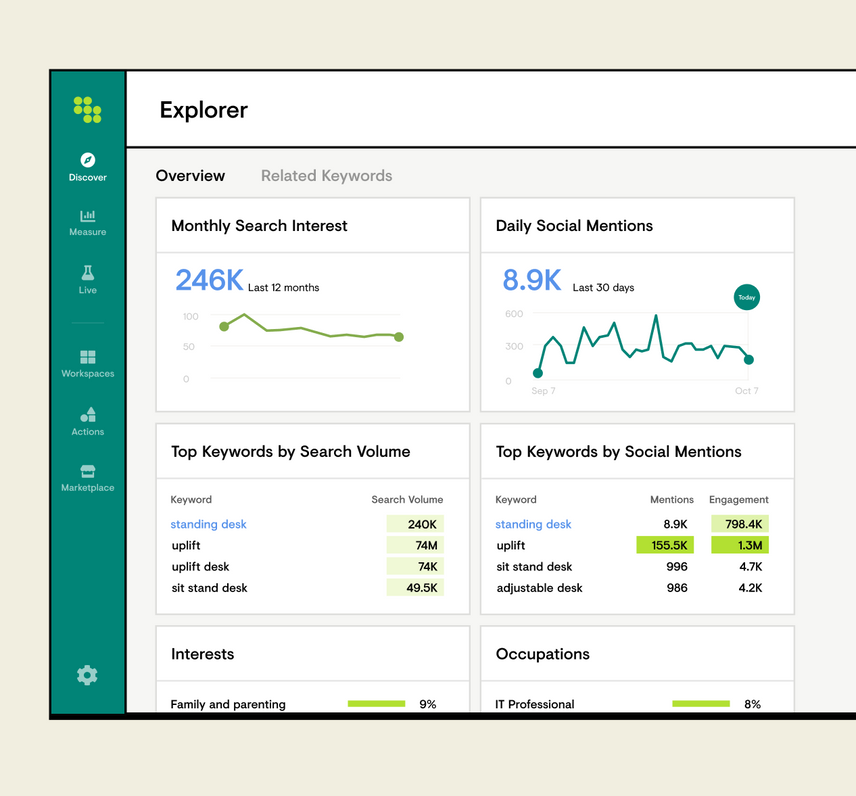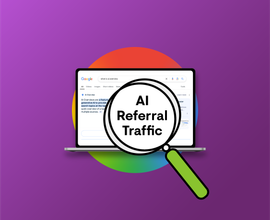Understanding The Voice of Your Customer: 3 Easy Steps
Even with so many marketing channels, understanding customer needs and identifying the voice of your customer still poses a significant challenge to most marketers. However, it's the key to increasing online visibility, crafting effective content and product messaging, and fueling business growth.
The best way to do so is by implementing these tried and true methods:
- Create focus groups to establish a direct feedback channel
- Tap into social listening for real-time insights
- Prioritize keyword research and analysis
Understanding the voice of your customer, along with their needs and wants, is mission-critical for marketers and businesses alike to achieve long-term success. After all, we all want to attract, convert, and retain customers—but we can’t do that unless we truly know them, what they need, and how they're looking for it.
From developing a new product feature to releasing a whitepaper, your business decisions should be driven by the needs of customers.
That said, it’s becoming increasingly difficult to cut through the noise and understand your customers’ expectations. Too often, companies feel confident they know what their customer needs, only to plan a product launch, jumpstart a marketing campaign, or release new content that falls flat.
To avoid falling into that trap, you have to ask yourself—how can you better understand the needs and voice of your customer?
Understanding the voice of your customer
Getting to know your customer's needs is easier said than done. But there are some surefire ways to understand what matters most to your customers, what they need from you, what their expectations and requirements are, and how you can best deliver on those needs. Three of our favorites? Focus groups, social listening, and keywordKeyword
A keyword is what users write into a search engine when they want to find something specific.
Learn more research. Here are three simple ways to tap into these effective strategies.
1. Create focus groups to establish a direct feedback channel
What is a focus group?
Focus groups are a market research technique in which you collectively interview a small group of people who represent your target audience.
With so much data available through digital channels, it's easy to forget that the best way to better understand your customers and your customer's voice is to connect with them directly.
The goal of a focus group is to foster an open and honest dialogue with your customers. Through focus groups, you'll develop a deeper understanding of how your customers respond to your business, your product, and the solutions you provide. While pop culture often portrays the political focus group, focus groups are a powerful tool for marketers in all fields and industries.
Easy ways to facilitate online focus group feedback
If you can't get current and prospective customers in a room for a focus group, think outside of the box.
For example, you can send online surveys to gain feedback and hear directly from customers. There are a myriad of online survey tools available to solicit feedback from prospects and clients. SurveyMonkey and SurveyGizmo are two popular and easy-to-use survey tools.
If you are working with a limited budget, Google Forms is a free alternative that offers basic survey functionality.
2. Tap into social listening for real-time insights
What is social media listening?
Social media listening is the process of tracking and analyzing what is being said about your company or industry on social channels.
Social media has shifted the dynamic between customers and brands. Thanks to social media, customers now have the power to engage in a two-way dialogue with brands and make more informed buying decisions.
Around 88% of respondents reported they trust recommendations from people they know more than any other channel—often by reaching out to their social media networks, according to Nielsen's 2021 Trust in Advertising Study . Brands can leverage social media to understand customer needs and discover what their customers are looking for in a product and how they are talking about competing products.
How to use social listening
Keeping up with what your customers post on social media about your business, your product, or your industry is a great way to start getting a feel for the voice of your customer and how you can best serve them. You'll start to see trends and patterns related to which words they use most often, seasonality, and more that you can use to inform your business strategy. Additionally, social listening will reveal your customers' expectations and how you are delivering on those expectations.
With so much noise from social channels, it's helpful to have a social listening tool to gain insight. For example, Hootsuite is a helpful tool to monitor conversations across various social networks.
Tap into data on daily social mentions and top keywords by social mentions via Explorer in Conductor when researching content topic opportunities or evaluating product messaging. Easily review overall sentiment on any given topic to evaluate real-time opinions and public perception.

3. Prioritize keyword research and analysis
Keyword research and analysis also provide valuable insights into the voice of your customer. Use this data to inform your content, SEO, and product messaging strategy. If you know how your customers are searching online—and how they are searching for your company and industry—you can determine what they’re looking for and ensure you're showing up for those terms. Once you’ve done your research, you can channel it into creating or optimizing products, services, and content to better align with those needs.
For example, our customer P.C. Richard & Son analyzed keyword searches and discovered their customers weren’t searching for a "barbecue grill” online but a “gas grill” instead. The team then updated their content to match the voice of their customer. From there, customers looking to cook out could find an awesome gas grill from P.C. Richard & Son at the top of Google's search results. And P.C. Richard & Son? The company doubled its online sales.
Keyword research and analysis allowed P.C. Richard & Son to identify where they weren't aligned with the voice of their customer and adjust their content marketingContent Marketing
Content marketing is a marketing discipline with the goal of increasing awareness and scope for products and brands in the desired target group with content published on the web and offline.
Learn more strategy to reach a larger share of their target audience on SERPs.
How to do keyword research
While there are a lot of ways to conduct keyword research, one free option is our SEO Chrome Extension. Access key on-page SEO performance data and opportunities on everything from metadata, technical SEO, page health, links, and more—all in your go-to browser. View search metrics for relevant new keywords directly on any page you're viewing, powered by Explorer.
You can even investigate your competitors' search strategy and identify content gaps for new opportunities to provide value for your customers. The extension makes it easy to understand the voice, wants, and needs of your customer, so you can adapt your strategy to drive results.







